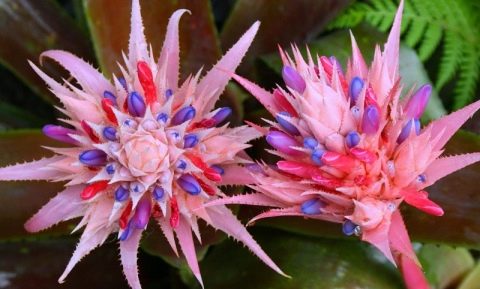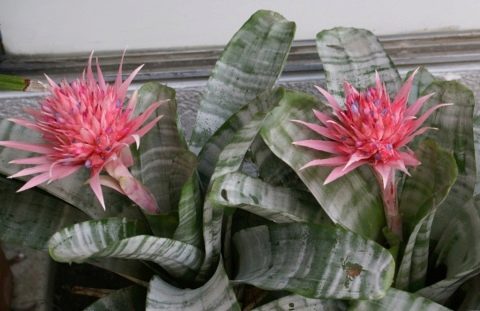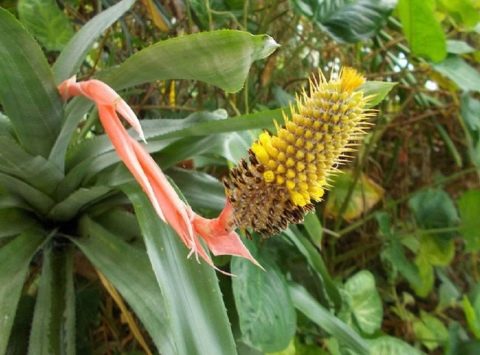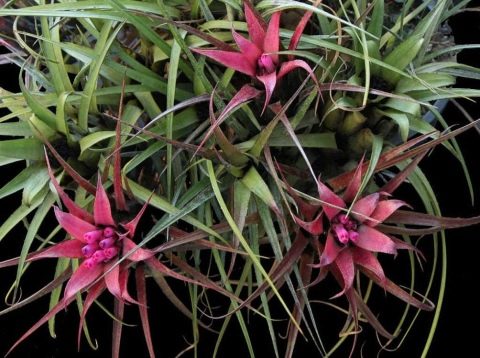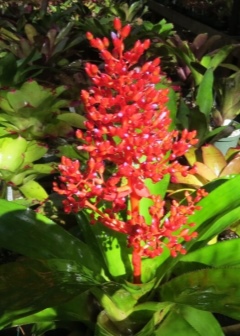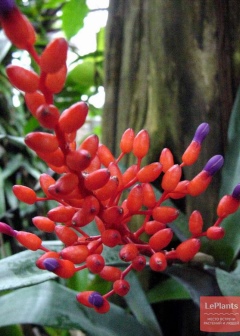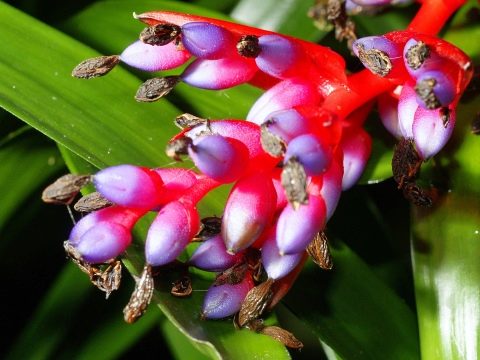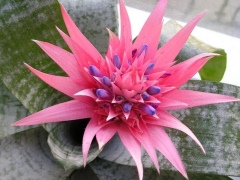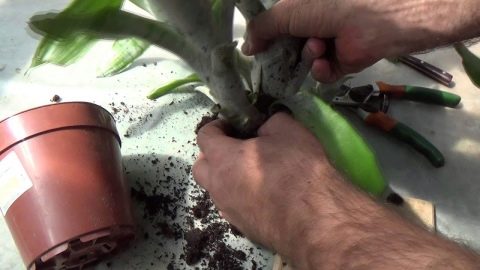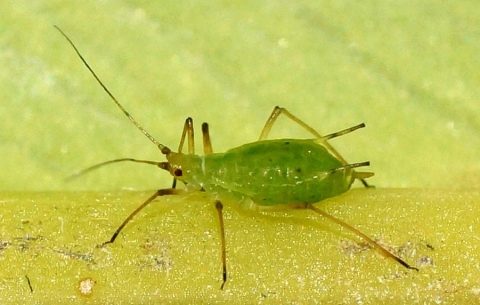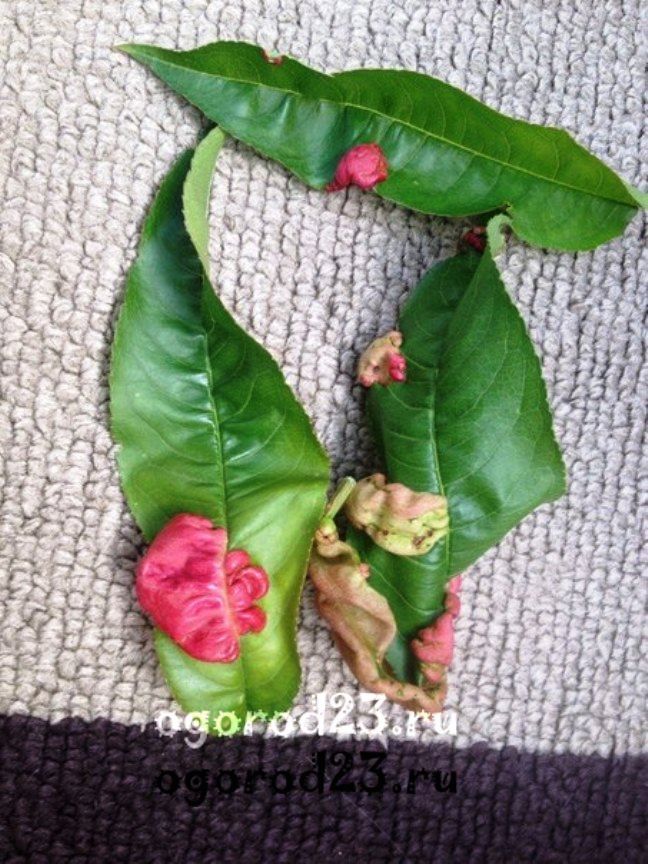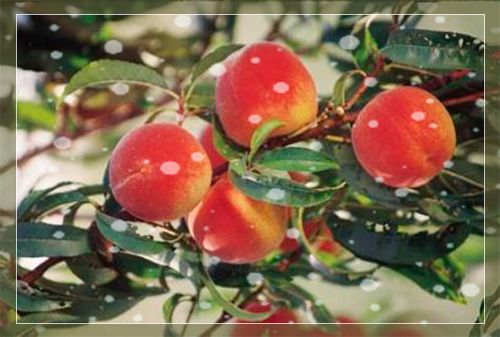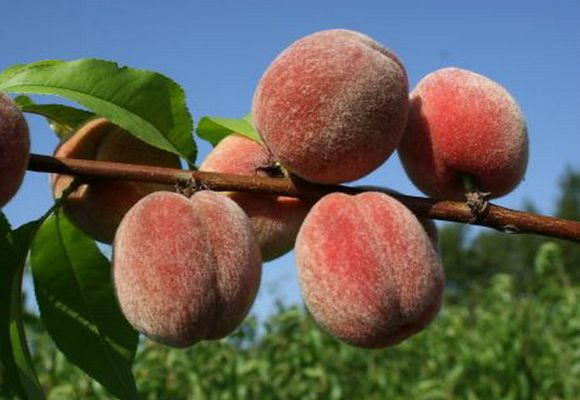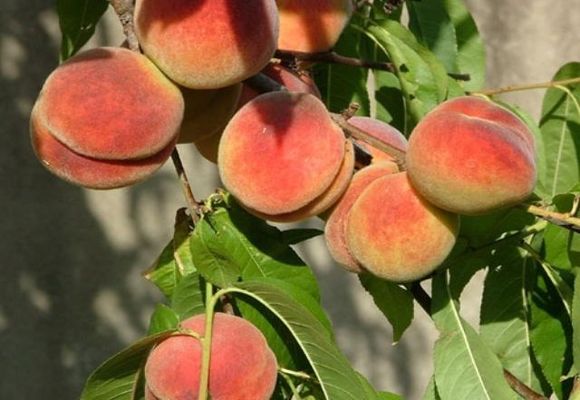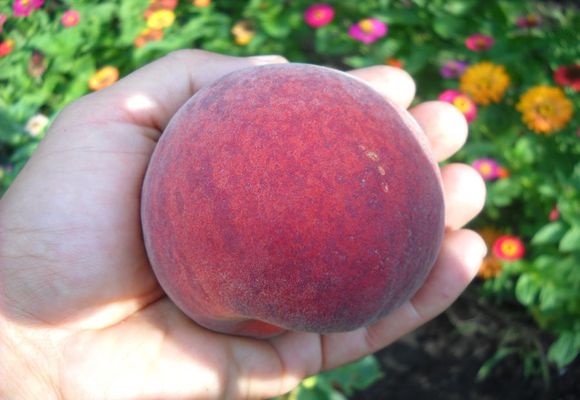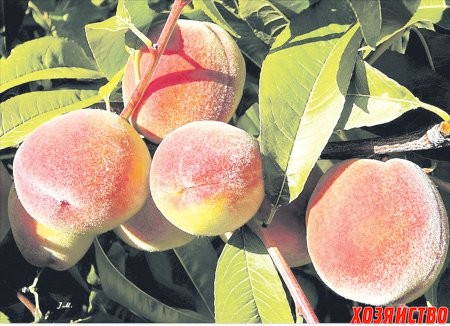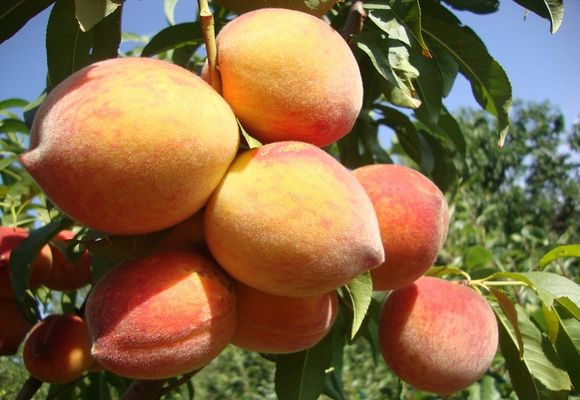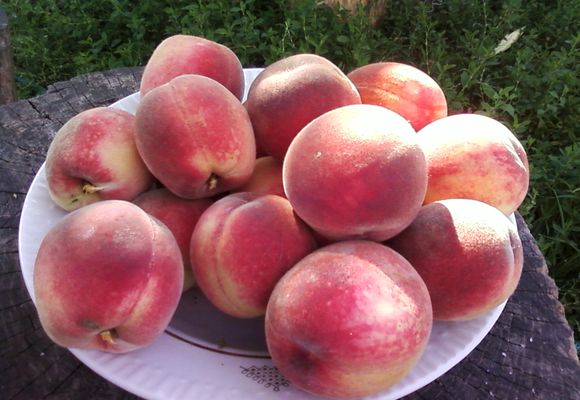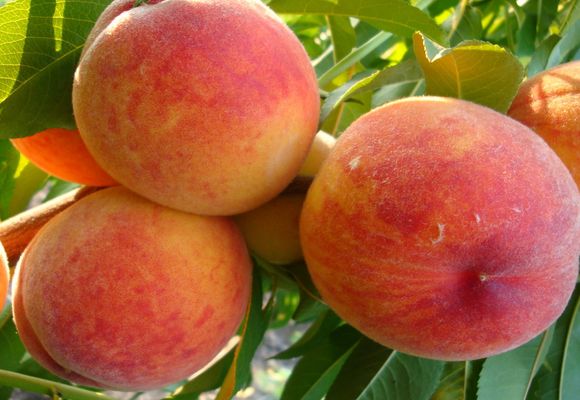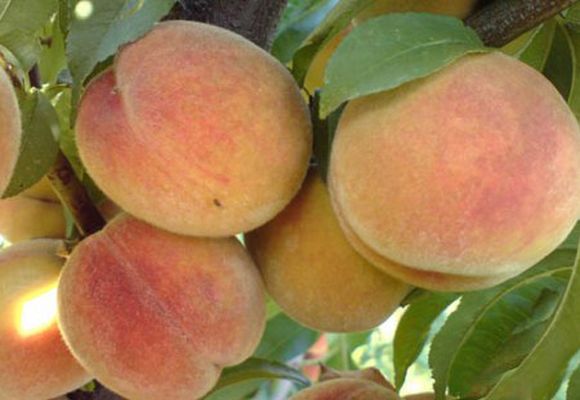Home care for echmea
Ehmeya attracts flower growers with an interesting and memorable appearance. But often mistakes in care lead to the loss of decorative qualities. To prevent this from happening, we suggest that you familiarize yourself with the basic rules for growing a crop.
Lighting and placement
For normal growth and development, the plant needs abundant lighting. In this case, direct sunlight is contraindicated. Prolonged exposure to ultraviolet light affects the leaf plates, resulting in brown and brown spots. The best option for placing a flower pot is a west, east or southwest window.
The duration of daylight hours should be at least 10 hours. It is recommended to install additional lighting in spring and autumn.
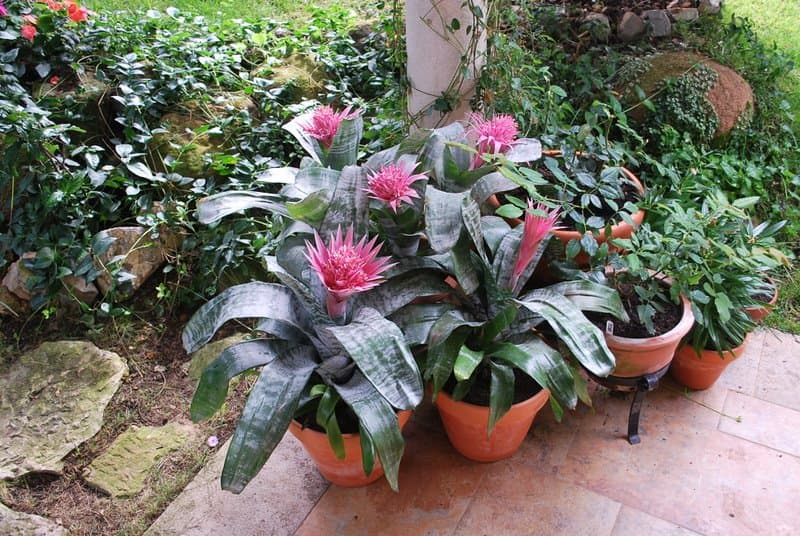 Tropical flower prefers diffused lighting
Tropical flower prefers diffused lighting
Temperature regime
Ehmeya belongs to thermophilic decorative crops. During the growing season, the indoor air temperature is in the range from +22 to +26 ° C. The plant can be taken out onto a balcony or terrace, avoiding direct sunlight.
In winter, when the flower is dormant, the temperature does not exceed +18 ° C. The room is periodically ventilated
Please note that tropical culture does not respond well to draft
Watering and humidity
Most tropical plants that are grown at home are demanding on air humidity. Ehmeya became an exception to the rule: the flower tolerates moderate dry air well. But don't abuse this ability. Keep the humidity in the room within 60–70%.
The plant is demanding for watering. You can moisten the culture according to the scheme described below:
Table: Recommended crop irrigation scheme
Fertilization rules
Plants of the Bromeliad family need additional feeding. Lack of nutrients in the soil can lead to a lack of flowering. The culture should be fed with liquid fertilizers for ornamental flowering plants
Please note that the concentration of the solution should be 1.5-2 times weaker than indicated in the instructions
Ehmeya loves both root and foliar feeding. During the growing season, the plant is fertilized every three weeks.
The nuances of transplantation and reproduction
The seed breeding method of echmea requires a lot of time and effort of the grower. Since the resulting seedlings often do not retain varietal characteristics, this method of cultivation is extremely rare.
A shallow container is filled with peat and crushed fern roots. The planted seeds are sprinkled with river sand and watered. Then the container with the seed is removed under the film and moved to a warm place with low light. Crops are systematically watered and aired. Approximately three months later, seedlings are picked. And only after 12 months, the matured shoots can be transplanted into separate pots.
Vegetative propagation is considered to be more productive and less problematic. Separation of lateral offspring is carried out in early spring. Before planting, the cuts are treated with crushed charcoal. For planting, a mixture of peat, leaf humus, coarse-grained river sand and vermiculite is used.
The plant is transplanted every two years. The procedure is performed in the spring. When transplanting, dry and faded leaf rosettes are removed. The pot can be left the same, and the soil must be replaced: for planting and growing echmeas, they use ready-made soil mixtures for Bromeliads.
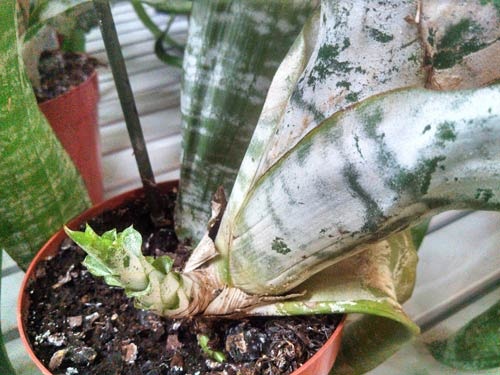 Ehmeya is propagated by separating lateral offspring
Ehmeya is propagated by separating lateral offspring
Is it poisonous or not?
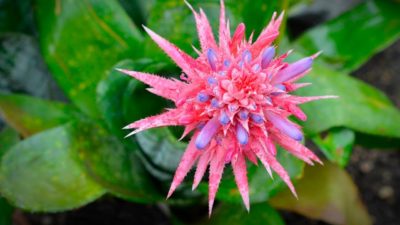 Ehmeya belongs to poisonous plants. If the poison comes into contact with the skin, it causes irritation.
Ehmeya belongs to poisonous plants. If the poison comes into contact with the skin, it causes irritation.
Therefore, when working with a flower, it is necessary to wear rubber gloves. After work, hands are thoroughly washed with soap.
The flower is kept away from children and pets.
What if it doesn't bloom?
It often happens that ehmeya does not bloom at home. This is influenced by the following factors:
- Lack or excess of sunlight.
- The room temperature is low.
- The pot is too big.
- The humidity level is very low.
- The presence of diseases or pests.
In these cases, it is recommended to adjust the care of the plant.
Some gardeners use the following tricks to speed up flowering:
- An orange or apple is placed near the pot with the plant, and everything is covered with foil and left for 2 weeks. The flower appears after 3-4 months.
- The plant is rearranged to a cooler place, since it is believed that temperature drops have a good effect on flowering.
- Ehmei put a little calcium carbide in the outlet. When interacting with water, it releases a gas that promotes flowering.
In winter, the plant must be given a rest, since it is at this time that the flower begins to be laid. The air temperature is lowered to 18-20 degrees. Watering infrequently and accurately.
Types and varieties for indoor breeding
The genus Ehmeya is very diverse, several dozen species belong to it. The following is a description of the varieties that are best suited for home growing.
Note! Ehmeya is watered twice a week, and in the heat it is also sprayed once every 24 hours.
Ehmea striped or fasciata (Aechmea fasciata)
Its belt-like greenish-gray leaves with marble-white stripes are collected in rosettes, and pink inflorescences are pyramidal in shape. For her, it is better to choose partial shade. Caring for striped echmea at home consists in watering and feeding. Watering is carried out at the root as the earth dries up. Fertilize by spraying with low-concentration bromeliad solution.
Ehmeya Primera
Rigid and curved leaves adjoin each other, the plant height reaches 65 cm. An example has bright pink bracts and red-purple flowers. Requires regular watering with filtered water. In the summer, moisturize the root and rosette. Top dressing is carried out using a spray bottle, spraying the leaf plates with a special solution.
Note! Ehmei Fasciata, Primera and all other species, feel good at an indoor air temperature of + 14-17 degrees in winter and + 20-26 degrees in summer
Ehmeya Shining
The plant has a belt-like green leafy rosette, leaves rounded with denticles along the edge, and also pink bracts and coral-red flowers. The inflorescence can contain up to 100 flowers. Aechmea fulgens is photophilous; in winter, the optimal temperature for it is +18 degrees, and in summer - + 20-27 degrees. In hot weather, the water in the leaf funnel should be constant. During the flowering period, fertilizing is required twice a month.

Pot with sparkling echmea
Ehmeya red matte (Aechmea miniata)
This variety has green and tapered leaves with scales on the surface and thorns at the edges. They are assembled into a funnel-shaped socket. During flowering, a red peduncle with a pyramidal inflorescence appears from the outlet. The main advantage of matte red echmea is long flowering.
Ehmea Weilbach (Aechmea weilbachii)
The length of its soft-skinned green leaves reaches 50 cm. At the base, they are painted in a copper-red hue and do not have prickly edges. The flowers of the echmea are lilac-blue. An erect peduncle grows up to 50 cm in height.
Ehmea two-row (Aechmea distichantha)
This plant has a spreading deciduous depression, which can reach 1 m in diameter. The leaves are green and elongated, the flowers are purple with bright red bracts.
Ehmea curved (Aechmea recurvata)
The leaves are narrow and long - up to 40 cm, in width - up to 1.5 cm. The bract is red. The inflorescence is capitate and up to 20 cm long.Leaves with pointed edges form a tubular rosette.
Ehmea shaggy (Aechmea comata)
Echmea shaggy has yellowish flowers with reddish bracts. The shape of the inflorescence is spike-shaped. Leaves are belt-shaped, with spiny edges. It blooms in winter, has another name - Linden's ehmeya.

Yellow beauty on the windowsill
Ehmeya: home care and reproduction
The flower can be propagated using seeds or by planting shoots.
Echmea propagation by shoots
A faded echmea sprouts. But they cannot be transplanted immediately. They should grow up to 15 cm and take root. The process of propagation by shoots is as follows:
- the ehmey must be taken out of the pot and the children with the roots must be separated, the cut site must be disinfected;
- a container with a diameter of 8-9 cm is filled with a mixture of coarse sand and peat;
- the shoots are placed in the soil. The container is covered with foil and placed in a warm and bright place.
When the shoots are well established, they can be planted in separate pots and cared for as an adult plant.

Plant propagation by shoots
Growing from seeds
This is a difficult and less popular way of breeding echmea. When using it, the plant may lose its varietal characteristics. The breeding process is carried out in the following sequence:
- Seeds are sown in a container with peat at a shallow depth.
- The container is covered with polyethylene, periodically the film must be removed so that the soil can be ventilated and moistened.
- After 3 months, seedlings are planted in separate pots with leafy soil.
- After a year, the seedlings are transplanted into the soil for adult plants.
The optimum temperature for seeds is + 22-24 degrees, and for seedlings - from +20 to +22 degrees.
Echmea care
The plant blooms from May to October and only once. But even with short-term flowering, watering should be regular. In addition, the plant needs to be fed. Fertilizers are applied from March to September.
Note! The top dressing should not contain boron and copper, which have a detrimental effect on ehmeya. The plant rests in winter
At this time, buds are formed. During the rest period, the temperature in the room should not fall below +16 degrees
In winter, the plant rests. At this time, buds are formed. During the rest period, the temperature in the room should not fall below +16 degrees.
Why ehmeya does not bloom at home
There are several factors that have a detrimental effect on the plant and prevent flowering:
- Do not expect flowers ahead of time. A seedling grown from seeds will open only for 5 years, and a planted shoot - after 3 years. It is impossible to make ehmeya bloom earlier.
- Unfavorable temperature conditions. In summer, the flowerpot should grow at a temperature not lower than + 22-26 degrees; in extreme heat, frequent spraying is required. The bud is formed in the autumn-winter period, so coolness is necessary (+ 17-21 degrees).
- Lighting. The plant requires constant light, but should not be exposed to direct UV rays. The sun can cause burns and, as a result, there will be no bloom.

Reasons for the lack of flowering
Ehmeya flower is a beautiful and rather unpretentious plant. The only drawback is short-term flowering. In any case, you should know how to care for an exquisite ehmeya flower and why it does not want to bloom.
vote
Article Rating
Reproduction methods
This culture can be propagated through two options - seeds or daughter shoots. The latter method is the easiest and gives the best results.
Daughter shoots
At the end of flowering, echmea gives daughter shoots. To obtain a new individual, it is required that the shoot is equal to half the size of the mother plant (at least 15 centimeters), and it must also have its own root system.
What do we have to do?
- Remove the main plant and shoots from the pot.
- Cut off the shoots using a sharp, clean knife.
- Sprinkle the cut with crushed activated carbon and dry.
- Pour a mixture of two parts of leafy soil, one part of peat and one part of coarse sand into a suitable container.
- Plant a new plant in the ground, cover it with a polyethylene bag to create a greenhouse effect.
- Place the pot in a warm and bright place.
- At the end of rooting, move the plant to a larger pot and take care of it in the usual way.

Ehmeya can be propagated by daughter shoots
Seeds
This activity is more difficult than reproduction by offspring, so not many gardeners choose it. Ehmei grown from seed are capable of losing certain characteristic features of the variety.
What to do?
- Fill the planting pot with chopped peat.
- Plant the seeds not too deep.
- Cover the container from above with glass or a bag.
- Put the pot in a place where direct sunlight cannot get, constantly water and ventilate.
- As for the temperature, it must be maintained at 22-24 degrees.
- It will take 3 months before ehmeya rises. Young plants are pricked using a mixture of leafy and heather soil.
- Seedlings are left at a temperature of 20-22 degrees Celsius, constantly watering and spraying.
- After a year, the culture can be placed in the ground for adults.
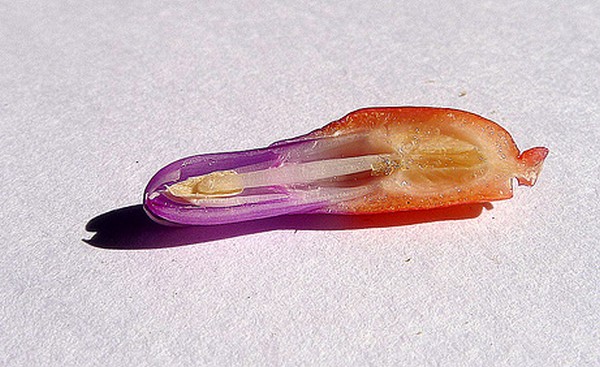
Propagating ehmeya by seeds is somewhat more difficult.
Ehmeya is a plant with a high aesthetic value. For good growth and flowering, it is necessary to properly organize the environment.
Basic conditions

Beautiful bloom in favorable conditions
Growing a plant in a confined space is easy. Ehmeya is able to adapt well to her environment. In order to avoid upsetting from its unsightlyness, the following care features must be observed.
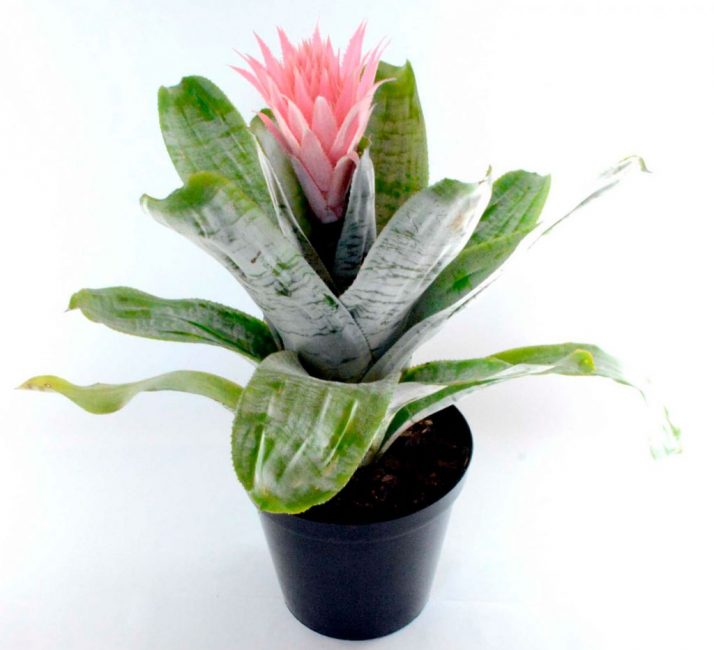
Ehmeya
The best option for planting placement is windows on the west or east side. Direct exposure to bright light is harmful. If it is impossible to place the echmea away from the southern window sills, shading will be needed.
In summer, if it is warm, it will be useful to move to an open space, at least to a balcony. Learning to new things does not happen abruptly, otherwise damage from high temperatures may appear on the crown. This rule must be adhered to for recently appeared acquisitions, so that bright light does not harm him, or if it has been rainy for a long time.
Ehmeya glittering is the most intolerant to the effects of bright and scorching rays. It is better for her to choose shaded corners. Ehmeya curved is demanding on a lot of lighting. With its lack, the foliage is less saturated in color, and the flowers are not very beautiful.

Ehmeya striped
Ehmeya is thermophilic. In warm seasons, she needs a temperature of + 22 ... + 26C, in winter - + 12 ... + 18C.
At the initial stage of flowering, it is necessary to prevent the temperature from dropping below + 23C. After the full blooming of the buds, the acceptable temperature in the room will be in the range of + 15 ... + 21C.
To stimulate flowering, and the peduncle is normally formed, a temperature difference between day and night is recommended. But you should avoid a sharp drop or increase in temperature, so as not to cause a stressful state.

Ehmeya
Where the flower is located, there should be fresh air whenever possible, so the room should be regularly ventilated. But drafts are not allowed.
Specifically, for the sparkling echmea, the exchange of air is not necessary and its wintering is permissible even in hot rooms.

Ehmeya striped
When the plant is watered, water flows under the crown and into the depression of the foliage. The water used is settled and, if it is very cold, warmed up a little.
During warmer seasons, irrigate abundantly and over the top of the flower. This is done when the top of the soil composition dries out.
In the cool off-season, irrigation is required infrequently and in small quantities. The ingress of water into the foliage is unacceptable.
If the winters are very cold, watering should be treated with great care.If necessary, using a sprayer, only the surface of the leaves is moistened with cold water
After the pet has bloomed and during rest, water is not allowed to enter the outlet. This will contribute to the appearance of rot and destroy it.

Ehmeya
The reduced level of moisture in room conditions from operating heating is not a terrible indicator. For the full growth and development of a green friend, it is better to control this level and, if possible, try to increase it.
To this end, the flower is often sprayed, and a tray is placed under the pot, into which a moistened lightweight porous material is poured. This will help with the problem when the tips of the leaves dry.

Ehmeya
The plant is fed all year round. This helps his normal development. Liquid mineral preparations are used as a vitamin remedy.
Feeding frequency:
- spring - summer - once / 2-3 weeks
- autumn - 1 time / month
- winter - 1 time / 6 weeks
The flower has unpretentiousness in the choice of container in which it will grow. A not very thick layer of drainage (expanded clay, crushed brick) on the bottom of the pot is required.

Ehmeya at home, transplant and reproduction
The earthen composition is taken from a store or prepared independently. A soil mixture that meets the requirements of the plant - peat, sand, deciduous soil (1: 1: 2). It is possible to use a composition of equal parts of humus and leafy soil and moss.
For the 2nd option, the mandatory addition of sand and finely ground shards to the soil is required.
Transplanting is necessary every spring. Flowering should be over by that time. At this moment, all faded bushes are removed.
You do not need to trim the flower. Only faded rosettes that have withered are exposed to the cut. The peduncle can also be cut if it has not fallen off on its own. In case of death of leaves, they are also removed.
Winter is the time for the plant to rest. During this period, the laying of the future peduncle takes place. The temperature should not drop below + 16C. Ehmeya is watered neatly. It will be more useful to spray it, while preventing water from entering the central part of the flower.
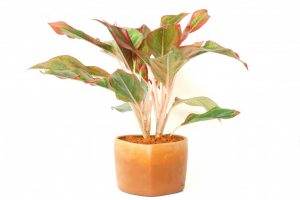
Aglaonema: description, home care, reproduction, varieties (100+ Photos & Videos) + Reviews
Home care
Ehmeya belongs to the Bromeliad family. In nature, it can only be found in South and Central America. Some species attach to the trunks of other plantsbut do not harm the wearer. The leaves are rosette and can be solid or striped.
During flowering, a long pink peduncle appears, after which it dies off.

What does an ehmeya flower look like
Several types are grown at home:
- fasciata is the most popular echmea. The leaves are narrow and long, collected in a rosette, colored in light and dark shades of green. The inflorescence reaches a size of 30 cm, and the babies grow on creeping stems;
- the example reaches a height of 65 cm. The leaves are dense and curved, the flower is red-purple;
- sparkling, or Aechmea Fulgens - the most unpretentious in the family. The width of the leaf does not exceed 6 cm, and the length is 40 cm. The edges are decorated with small denticles, the outer part is painted in a purple hue. Ehmeya sparkling is distinguished by unusual colors - red with a blue top;
- Weilbach - the leaves are leathery and soft, reaching a length of 50 cm.The color of the plate is green, which gradually turns into red.
- the two-row echmea has thorns along the edges of the leaves. The width of the plate does not exceed 3 cm, and the length is 50 cm. The peduncle reaches a length of 60 cm, and the flowers themselves are lilac with bright splashes of red;
- curved is characterized by narrow leaves that grow together into tubes. The edges are decorated with small thorns. The flowers are bright red;
- shaggy is distinguished by large leaves, which reach a length of 1 m. The edges are finely toothed. The flower is yellow with red bracts.
Ehmeya fasciata, glittering, examples and other varieties require almost the same care.These are light-loving plants that will thrive on western and eastern windows.
Important! The flower must be protected from the scorching sun, as it can cause burns. In warmer months, the pot can be placed on an open balcony.
In winter, additional artificial lighting is needed. Ehmeya example with a lack of light begins to fade
In warmer months, the pot can be placed on an open balcony. In winter, additional artificial lighting is needed. Ehmeya example with a lack of light begins to fade.
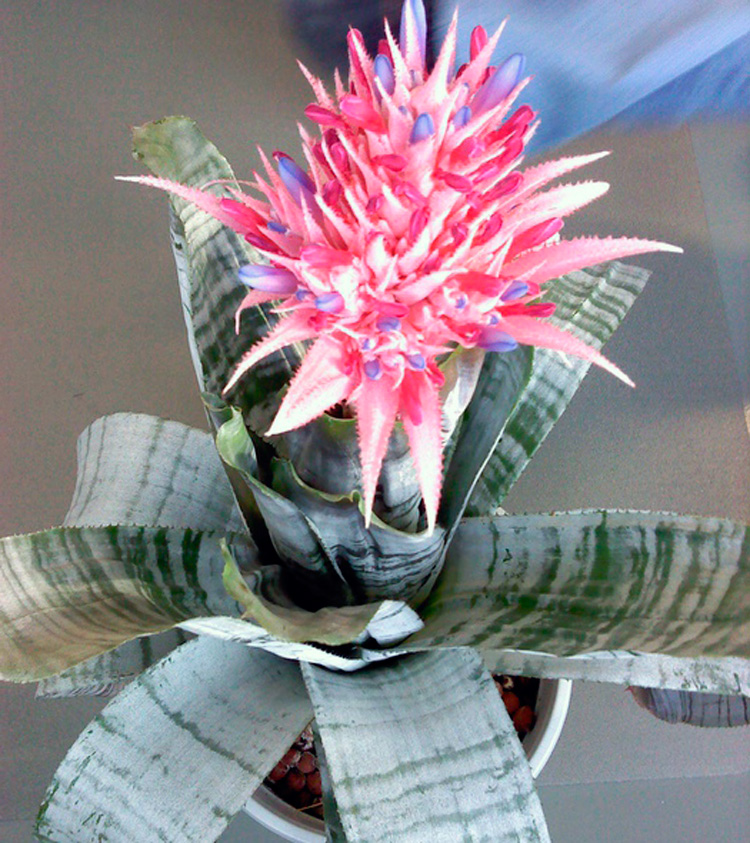
Flowering is an indicator of creating the right conditions for keeping
The temperature in the warm season should be around 25 ° С, in the cold - 20 ° С. The plant loves fresh air, so the room where the process stands must be constantly ventilated.
Watering features
In nature, the flower can be found in rainforests, so it loves moisture. Ehmea fasciata (Aechmea Fasciata) loves watering not only the earth, but also the outlet. Therefore, water is carefully poured into the place of articulation of the leaves.
In the summer, once a month, the houseplant is gently washed under a warm shower. In winter, the outlet cannot be watered, only the soil. Excess moisture is drained from the pallet.
Note! Ehmeya is constantly sprayed from a spray bottle. In the heating season, containers with water are placed next to the pot.
The moisture will evaporate and prevent the air from getting dry.
Ehmeya home care is not particularly difficult. It is enough to put the pot in a bright place, away from drafts. Variegated specimens are more sensitive to temperature conditions.
Ehmeya home care
All growers who want to have ehmeya at home should know the basic rules and subtleties of flower care. If they are observed, the plant will delight with its beauty and good growth.
Temperature
Most of the species are thermophilic plants. In summer, the temperature of the content must be maintained in the range from 22 to 27 ° C, in winter - at least 18 ° C. The plant tolerates changes in temperature normally, moreover, the nighttime drop in temperature has a beneficial effect on its growth and stimulates the development of the peduncle.

Lighting
Ehmeya indoor flower refers to light-loving plants that prefer soft, diffused light. In summer and late spring, to prevent burns, it is advisable to protect it from direct sunlight. In winter and autumn, in conditions of short daylight hours, you can organize additional illumination using special lamps.
The conditions of detention to some extent depend on the type of ehmeya. For varieties with hard leaves, bright light is most favorable. Species with soft leaves prefer moderate lighting, it is desirable to keep them in partial shade.
Watering and humidity
Ehmeya is a moisture-loving plant, so you need to water it regularly, avoiding the complete drying out of the soil.
The watering procedure itself has some peculiarities. First, you need to pour some water into the funnel formed by the leaves, and then moisten the soil. Under natural conditions, rainwater accumulates in such a kind of funnel, providing the plant with the necessary moisture during dry periods. In winter, as well as at temperatures below 18 ° C, you should limit yourself only to moistening the soil, otherwise the flower may begin to rot. It is advisable to use soft, warm water for watering.
The indoor flower ehmeya does not have special requirements for air humidity, but in conditions of elevated temperatures, in hot weather and when near heating batteries, it is advisable to periodically spray the plant with warm water.
What diseases and pests are prone to

Root rot
Common diseases and pests:
It may appear if the soil is waterlogged. In this case, the foliage turns yellow and withers. The problem can be solved only at an early stage. For this, damaged roots, which have darkened, and the affected leaves are cut off. The plant is treated with a fungicidal preparation.Then you need to transplant the ehmeya into new soil.

Sooty mushroom
Typical features are the appearance of a continuous film shell on the surface of the leaves and stem. This leads to a deterioration in photosynthesis and wilting of the entire plant. The cause of this ailment is pests (scale insects, aphids, worms). For the fight, pests are first removed. The foliage is then rinsed with clean water.

Shield
Its main attack is on leaf plates. From this, they begin to curl, turn yellow and die. The plant itself slows down its growth. Signs of the pest are brown plaques along the veins on the back of the leaves.
In addition, the leaves and shoots are covered with a sticky substance. At the initial stage, you can get rid of the pest with cotton wool soaked in alcohol, as well as a solution with dissolved soap. With a strong spread of the disease, insecticidal preparations are used.

Spider mite
A sign of the presence of this pest is a thin cobweb, which is noticeable with a very close examination. The surface of the leaves is covered with brown specks. As a result, the foliage turns yellow and unlocks.
To prevent this insect, it is necessary to observe the norms of humidity in the room. To destroy it, insecticidal solutions are used.

Mealybug
Having settled on a flower, it spoils its decorative appearance. It is removed with soapy water or alcohol. For this, foliage is wiped. With a strong reproduction of the pest, a special preparation is used.

Root worm
The target of damage is the root part of the flower, which rots as a result. In the process of struggle, the frequency of watering is reduced and treatment with specialized solutions begins. If the roots are severely damaged, the plant dies.
Precautionary measures

It is very important to protect your hands.
Some types of flowers are poisonous plants. For example, ehmeya is striped. Its juice can cause severe irritation on the skin. When working with a plant, gloves must be used, and at the end, hands are rinsed well.
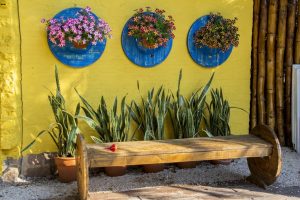
DIY furniture and other wood products: drawings of benches, tables, swings, birdhouses and other household items (85+ Photos & Videos)

